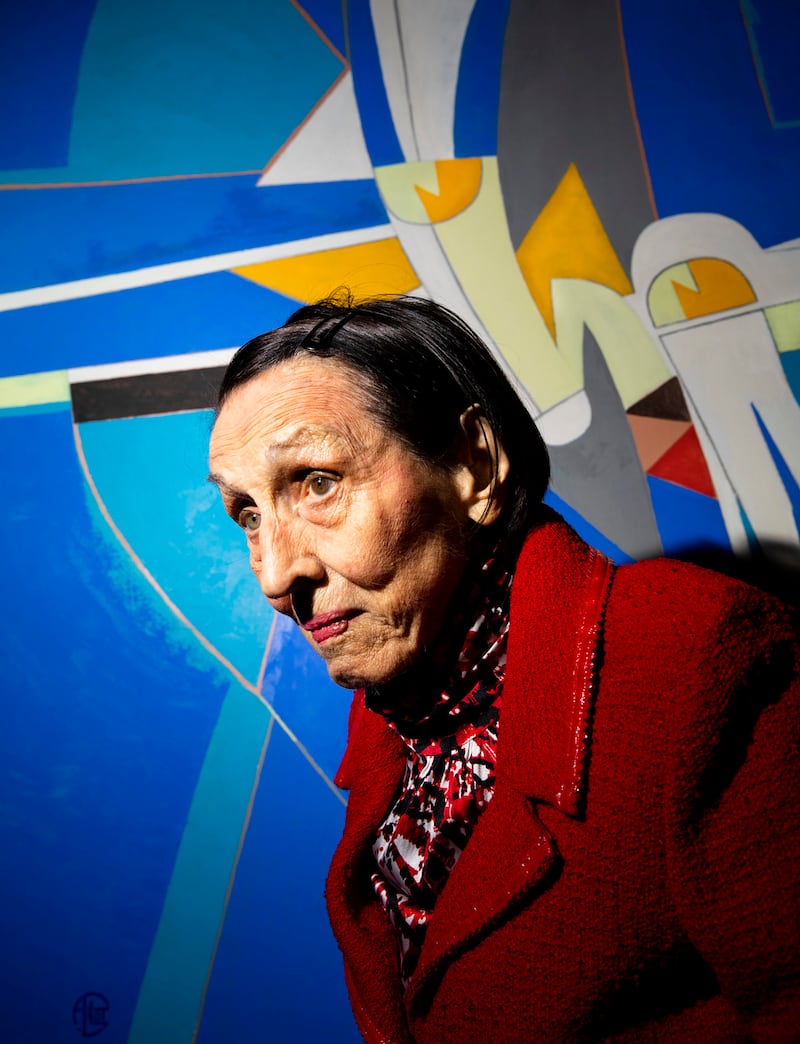Born: November 26th, 1921
Died: June 6th, 2023
In 1943 the artist Françoise Gilot, who has died aged 101, accompanied her teacher, the surrealist painter Endre Rozsda, to the Gare de l’Est in Paris. Rozsda was Jewish and Hungarian, and he was leaving for the apparent safety of Budapest. As his train steamed out of the station, the 21-year-old Gilot wailed: “But what am I to do?” Her teacher, laughing, shouted: “Don’t worry! Who knows? Three months from now, you may meet Picasso!”
Gilot was to recall those words as both prophecy and curse. Two months later she was having dinner when a short, bull-necked man approached her table proffering a bowl of cherries: it was Pablo Picasso. Forty years her senior, he invited her to his studio in the Rue des Grands Augustins. “He had such power that one didn’t notice his age at all. He was a man of intense physical energy,” she would later tell Irish Times journalist Lara Marlowe. By the end of the summer they were lovers.
The mismatched pair were together for a decade, during which time they had two children, Paloma and Claude. Picasso remained married to his first wife, Olga Khokhlova, throughout the relationship.
As Gilot was to recall in her best-selling book Life With Picasso (1964), he set out to undermine her from the start. Once, angry at her lack of attention to him, he burned her cheek with a cigarette.
From the early 1950s Gilot had begun to exhibit with members of the French réalités nouvelles school and when, finally, she was given a show of her own at Galerie Louise Leiris in Paris in 1952, Picasso refused to go to the opening. “Pablo wanted me continually pregnant, because then I was weaker.”

All this and more was revealed after their separation in Life With Picasso, which sold a million copies in the first year. Enraged, Picasso tried to prevent publication. When he failed, he set about destroying his ex-partner’s career, refusing to show his work at any gallery that showed hers, and cutting contact with their children. Already, in 1955, following Gilot’s marriage to the artist Luc Simon, the Leiris gallery had quietly dropped her. That, at least, was her story. Whether the gallery would have taken her on in the first place without Picasso’s cachet is a moot point. Still, it was through him that she met Georges Braque, Marc Chagall, Joan Miró, Gertrude Stein and Paul Éluard.
Summers in the early 1960s were spent cruising the Greek islands with Paloma and Claude on a chartered yacht with a crew of three. From these trips came what was to be perhaps Gilot’s most coherent body of artwork, the Labyrinth series. Inevitably critics descried Picasso in its southern colours and anguished forms. This was unfair. It was, generically, a work of its time, neither more nor less Picasso-esque than many other French paintings of the day. In return, some of Picasso’s best portraits had been of Gilot: his biographer, John Richardson, said: “Picasso took from her rather more than she took from him.” Nonetheless, Gilot remained dogged by his shadow, and not just as an artist.
She was divorced from Simon in 1962 and in 1969, in California, met the American virologist Jonas Salk, the developer of the polio vaccine. For the 25 years of their marriage Gilot would divide her time between Paris and Manhattan.
[ Francoise Gilot interview: Mistress of the masterOpens in new window ]
She was born in Neuilly-sur-Seine, an exclusive suburb of Paris. Her father, Emile, a rich manufacturer, was an authoritarian figure, forcing his left-handed only child to write with her right hand and insisting that she study law rather than art. Françoise’s lessons with Rozsda were a secret between her and her mother, Madeleine (née Renoult), a keen amateur artist. If Emile had been autocratic, his tyranny paled beside that of Picasso. She was, though, unique among his women in having survived him: his first wife was deeply affected by his treatment, as was another lover, Dora Maar. The model Marie-Thérèse Walter took her own life; his second wife, Jacqueline Roque, shot herself. Gilot lived on, painting every day.
Afflicted by growing blindness, she was as unsentimental about herself as she was the world at large. “Could a woman who was not beautiful have the life I’ve had?” she said in an interview with The Irish Times. “No; it goes without saying. But that was only part of it. It comes from within ... It’s my facon d’être, my way of being ... I never show more than one self at a time ... I succeeded in keeping my mystery.”
Salk died in 1995. Gilot is survived by Paloma, Claude and a daughter, Aurelia, from her marriage to Simon.
